
|
|
Für die deutsche Fassung bitte nach unten scrollen
|
|
|
|
|
|
ART&ANTIQUE in the Wiener Hofburg. We then continue at ART&ANTIQUE, the traditional art fair in the Wiener Hofburg. It takes place from 4 to 8 November. Our highlights there? We will disclose them in our next newsletter – alternatively, you are most welcome to visit us in our showroom in Vienna. This much we can say: Nobody has seen these top-quality pieces before.
|
|
|
|
Our Highlight of the Month:
|
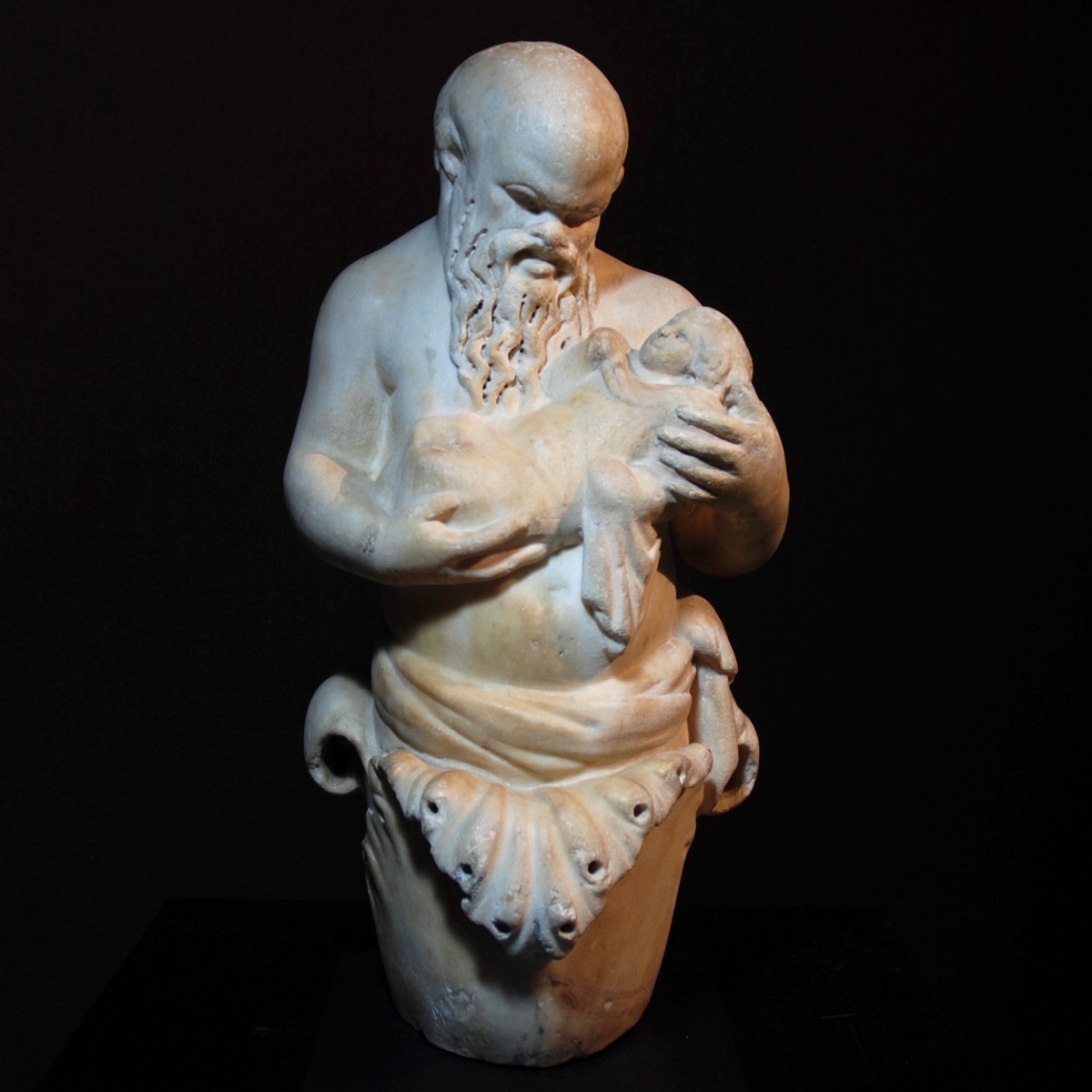
|
|
|
|
|
|
Roman Empire – 1st-2nd century A.D.
|
Magnificent and emotional marble statue of a bearded Silenus lovingly holding in his arms the little Bacchus who is still wrapped in blankets. The figure of the corpulent Silenus emerges from large acanthus leaves. Silenus has a shawl wrapped around his belly, his head is bald except for a hair wreath, his long, wavy beard reaches almost to his chest. His arms are bent, and he tenderly looks at the newborn Bacchus. The small child holds his right hand to his head and smilingly gazes at his protector. The divine Dionysus, called Bacchus by the Romans, was raised by the nymphs and silenoi far away from Mount Olympus. The reason was goddess Hera’s rage because her husband Zeus had had an affair with Dionysus’ mother Semele and fathered the child. The depiction of the fatherly Silenus is based on the Greek bronze statue of Lysippus, which was crafted around 300 to 280 B.C. The most well known Roman marble depiction is today in the Louvre with the catalogue number Ma 922. The depiction with the massive calyx as foot indicates that the statue served as a table leg (trapezophoros). Published in: Royal-Athena Galleries “Art of the Ancient World Vol. VI”, New York 1985, number 213. Mounted.
|
Provenance: Galerie La Reine Margot, Paris since the 1970s. 1984 with Royal-Athena Galleries in New York. There acquired by Marilynn and James A. , Chicago in 1985. Last in a family estate.
Dimensions: 49.5 cm high
Price: 60 000 Euro
|
|
|
|
Selected Artworks of the Month:
|
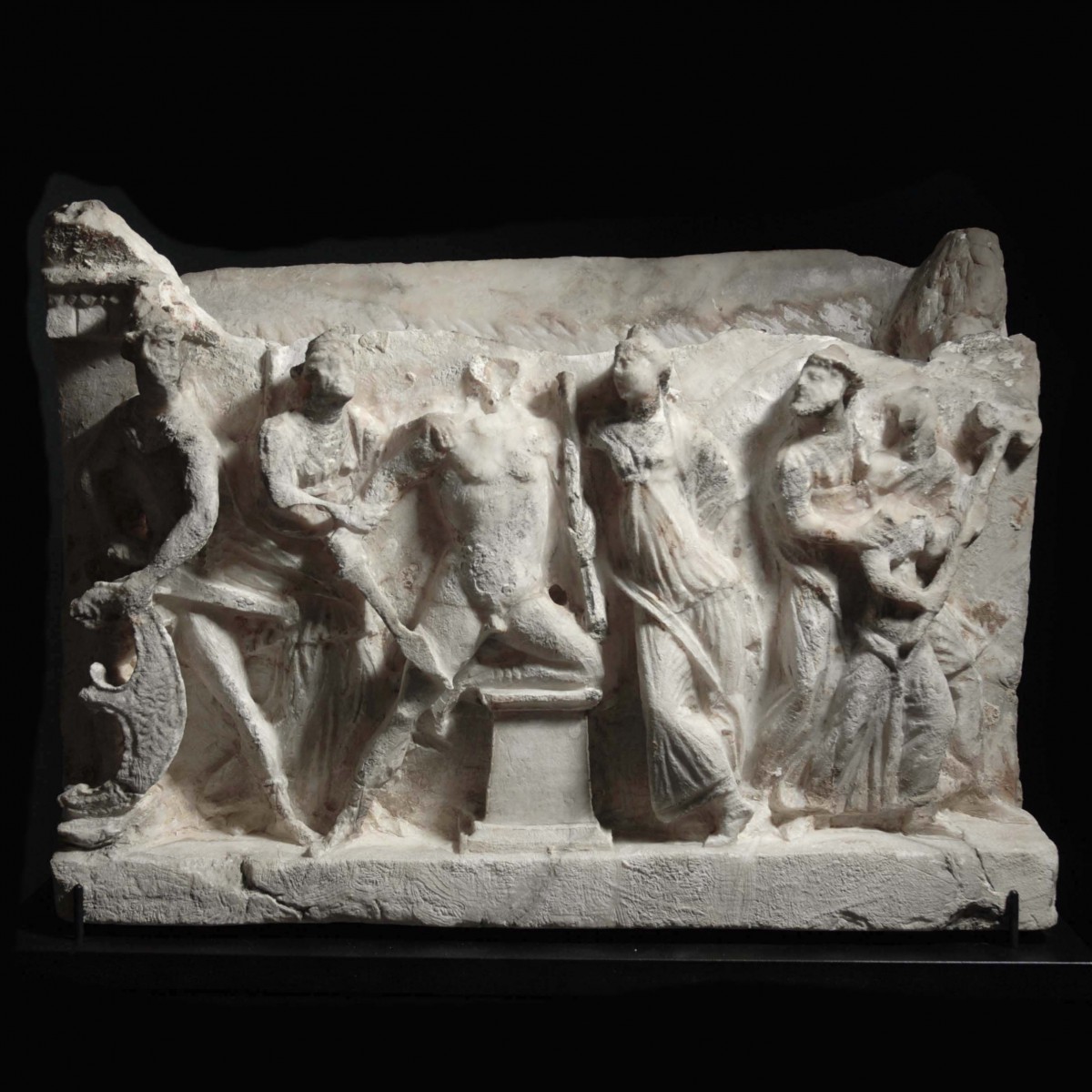
|
|
|
|
|
|
Etruria – 2nd century B.C.
|
Multiple published alabaster cinerary urn with a high relief on the long side depicting the recognition of Paris as son of Priam from the Trojan cycle. Paris in the centre, his knee for protection on Zeus’ altar. In his right hand holding a sword, in his left the victory palm branch. From the left side his brother Deiphobus grabs him on his arm and shoulder. Paris, supposedly to be a shepherd, just won the offering games for a bull, which was his favourite animal, and therefore offended the royal family. As they want to hold him accountable he flees to the altar. On the right stands his sister Cassandra, a priestess with the gift to see the future, who recognizes her brother, who was lost as a child and raised by shepherds. On the far right possibly the bearded king Priam looking agitatedly at the scene and holding back another armed person. On the far left another warrior with helmet, bow and sword. The side walls smooth. The urn with its dynamic depiction is published in: K. Hamma (ed.) “The Dechter Collection of Greek Vases“, San Bernadino 1989, page 83, number 4. Mounted.
|
Provenance: Christie’s New York auction in July 1984, lot 236. Thence in the Hainta and Aaron Dechter collection prior to 1989. Exhibited at the California State University San Bernadino and California State University Northridge from 5 May to 2 June 1989 and from 26 February to 30 March 1990.
Dimensions: 36 cm x 50.2 cm x 19 cm
Price: 14 000 Euro
|
|
|
|
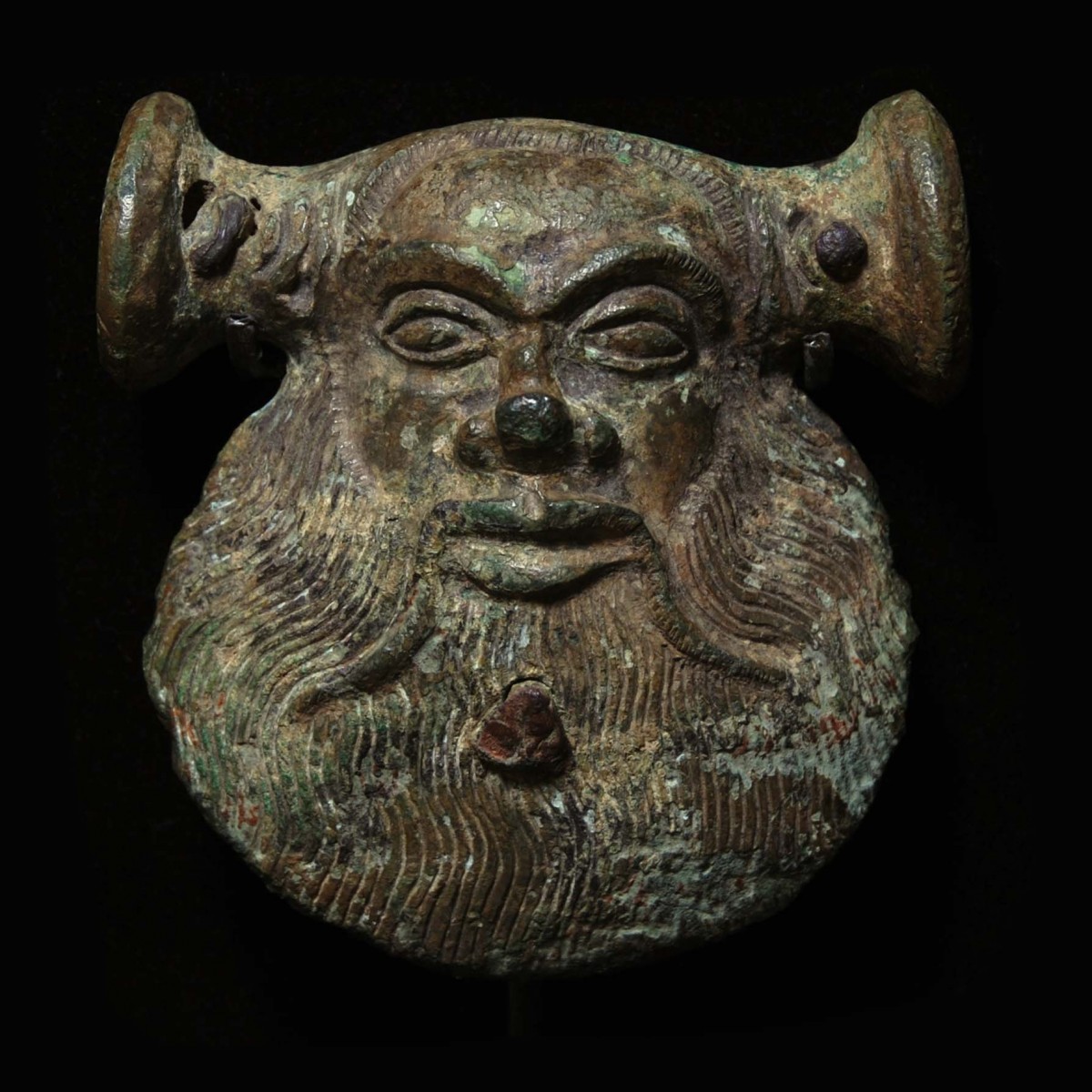
|
|
|
|
Greece – Early 5th century B.C.
|
Large and multiple published bronze mask of a Silenus. The magnificent applique, which once adorned a monumental situla from the Greek classical period, shows the expressive face of a bearded man. The beard is long and round, the strands are finely modeled. The long mustache hangs down from the mouth, swinging. Silenus has full lips with a point-shaped philtrum. The nose is bulbous, the bulging eyebrows frame the almond-shaped eyes, which look out from thick lids. The ears are indicated in relief in front of the distinctive rotelles. The hair is carved into the forehead in cold work. The three original pins with which the mask was attached are still preserved. Published in: H. Hoffman “The Beauty of Ancient Art, the Norbert Schimmel Collection”, Mainz 1964, number 16. O. Muscarella (editor) “Ancient Art, the Norbert Schimmel Collection”, Mainz 1974, number 31. J. Settgast "Von Troja bis Amarna, die Sammlung Norbert Schimmel", Mainz 1978, number 35.
|
Provenance: Private collection Norbert Schimmel (1905-1990), acquired prior to 1964 in New York. Thence Sotheby's New York "Important Antiquities from the Norbert Schimmel Collection" on 16 December 1992, lot 48. From there acquired by Herbert A. Cahn, Basel. From there acquired by the collection Donald Vollen, Basel in 1993. With Christie's London on 6 December 2017, lot 41. Last in a US private collection.
Dimensions: 10.6 cm x 10.4 cm
Price: 14 000 Euro
|
|
|
|
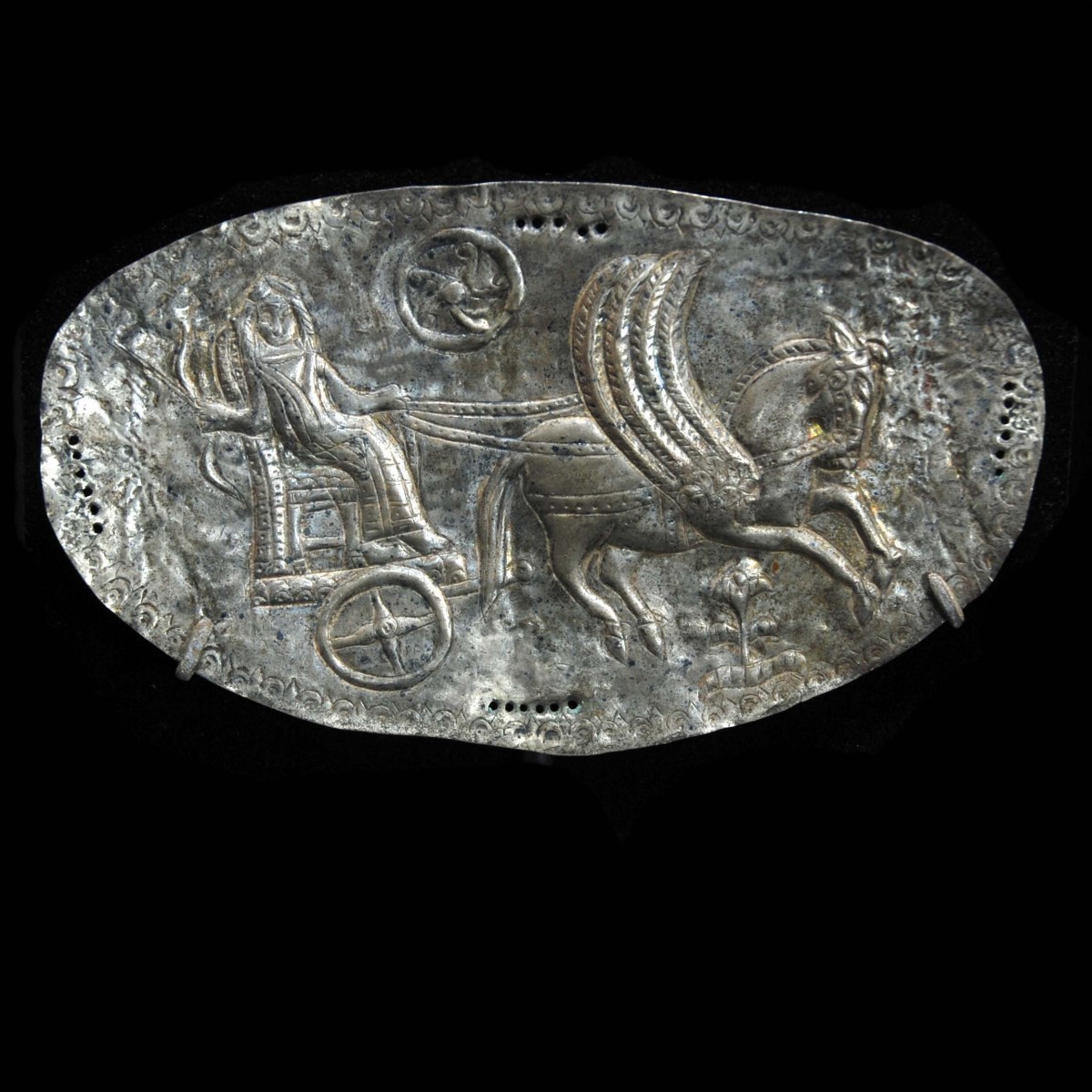
|
|
|
|
Thracia – 6th-5th century B.C.
|
Oval silver sheet with a wrought and punched depiction of a female deity seated in a richly decorated chariot pulled by a galloping Pegasus. She is holding a bow in her right hand and her face is turned towards the viewer. She wears a long robe and her hair cascades sideways over her temples. A sun gear above the scene. An encircling punched decorative border on the rim. A floral plant under the winged horse. Fine holes for sewing in four places. Mounted.
|
Provenance: From a German private collection. Thence auctioned on 11 April 2008 at Hermann Historica in Munich, Germany. Thence Royal Athena Gallery New York. Sold there on 14 August 2008. With a copy of the original invoice.
Dimensions: 9 cm x 15.2 cm
Price: 8 000 Euro
|
|
|
|
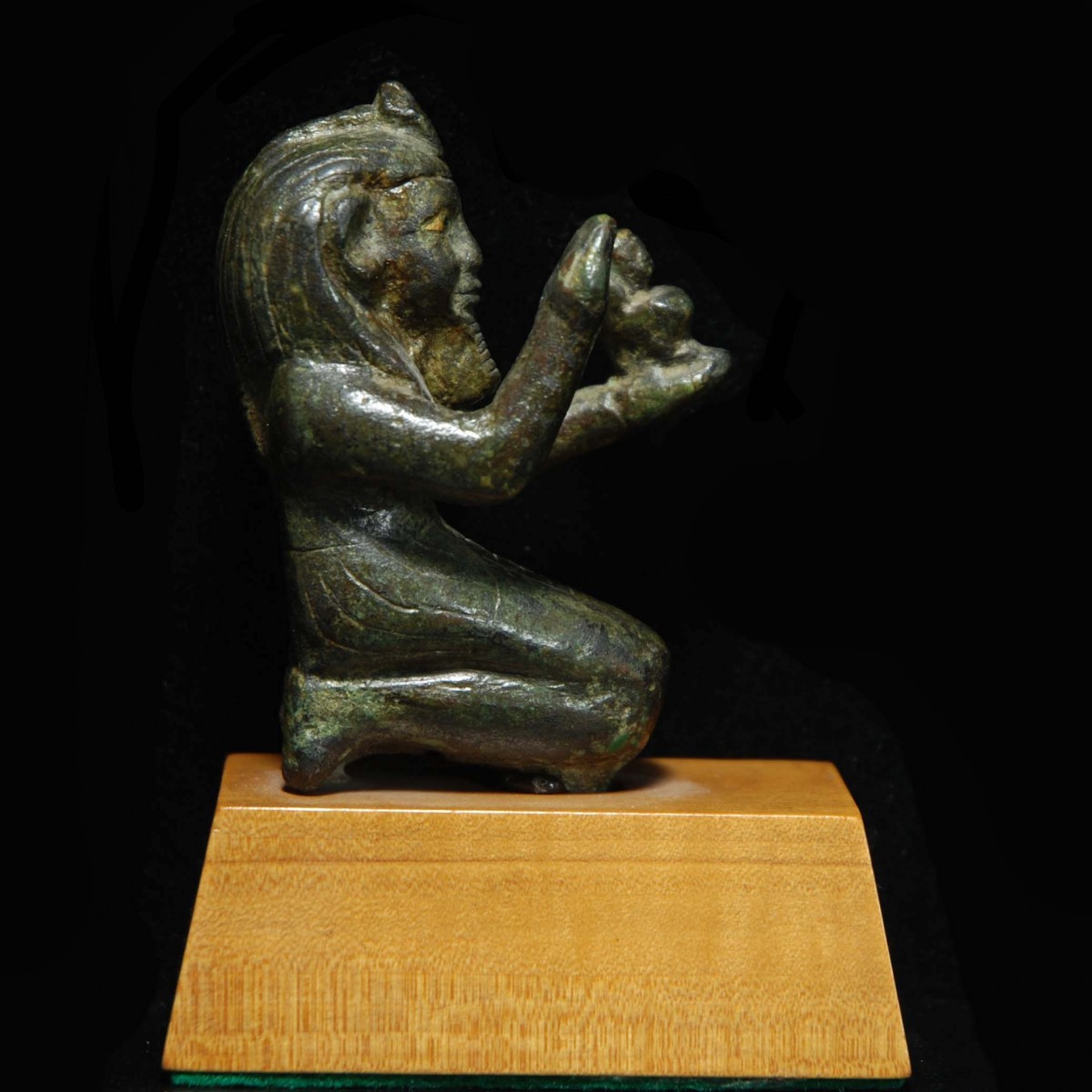
|
|
|
|
|
|
Egypt – Late Period, 3rd Intermediate Period, 25th dynasty, Reign of Taharqa, 690-664 B.C.
|
Solid cast bronze statuette decorated in cold work of a kneeling pharaoh with a nemes head cloth and striated beard. It possibly depicts Taharqa (690-664 B.C.) the most important ruler of the Kushite 25th dynasty in Egypt. His right hand is raised in a gesture of praise, and his left hand is stretched out holding as an offering a squatted Maat figure. Taharqa wears a long kilt which is decorated at the lap. On the forehead an uraeus. The eyes with gold overlay. Mounted with the original tenon on an old wood base.
|
Provenance: Reputedly from the Hilton-Price collection, end of the 19th century. Thence private collection Charles Bouché, acquired in the 1960s to the 1970s. Auctioned with Drouot on 15 November 2013, lot 176.
Dimensions: 6.5 cm high
Price: 4 800 Euro
|
|
|
|
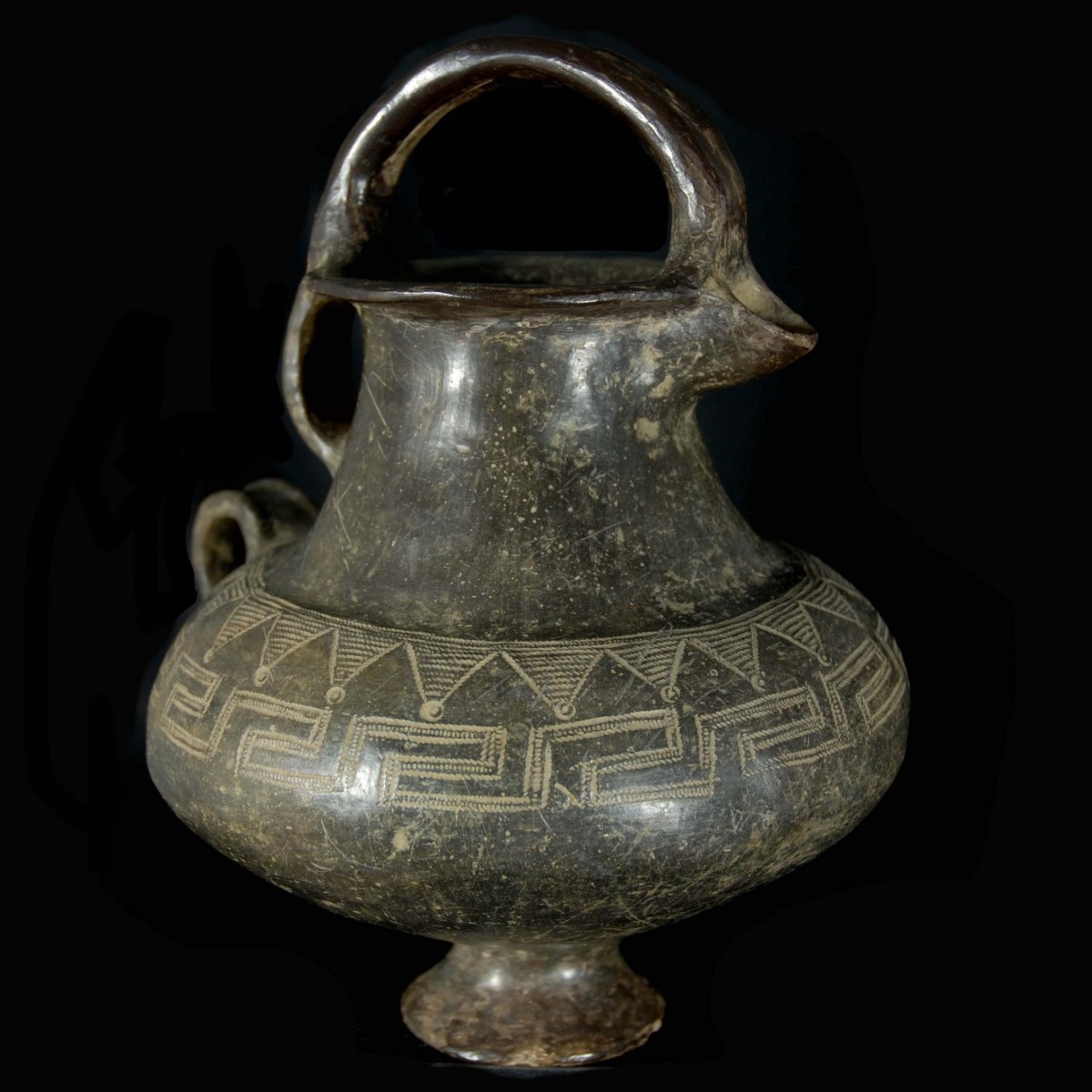
|
|
|
|
|
|
Etruria – 8th century B.C.
|
Early Etruscan or Villanovan stirrup jar of the Impasto Ware in a rare form. The jug with a protruding, round corpus stands on a high ring foot. The neck tapering towards the top, the rim is protruding. The stirrup handle applies behind the spout, sitting at the back on the rim and in an extended form reaches to the neck. On the back a broad ring handle. The body is decorated with a very diligently impressed décor. The upper band consists of triangles, which end with a hallmarked circle. Within the triangles fine line decoration. Below a broad band of meander.
|
Provenance: German private collection W.F., Munich, Germany, acquired in the 1990s.
Dimensions: 22 cm high
Price: 4 800 Euro
|
|
|
|
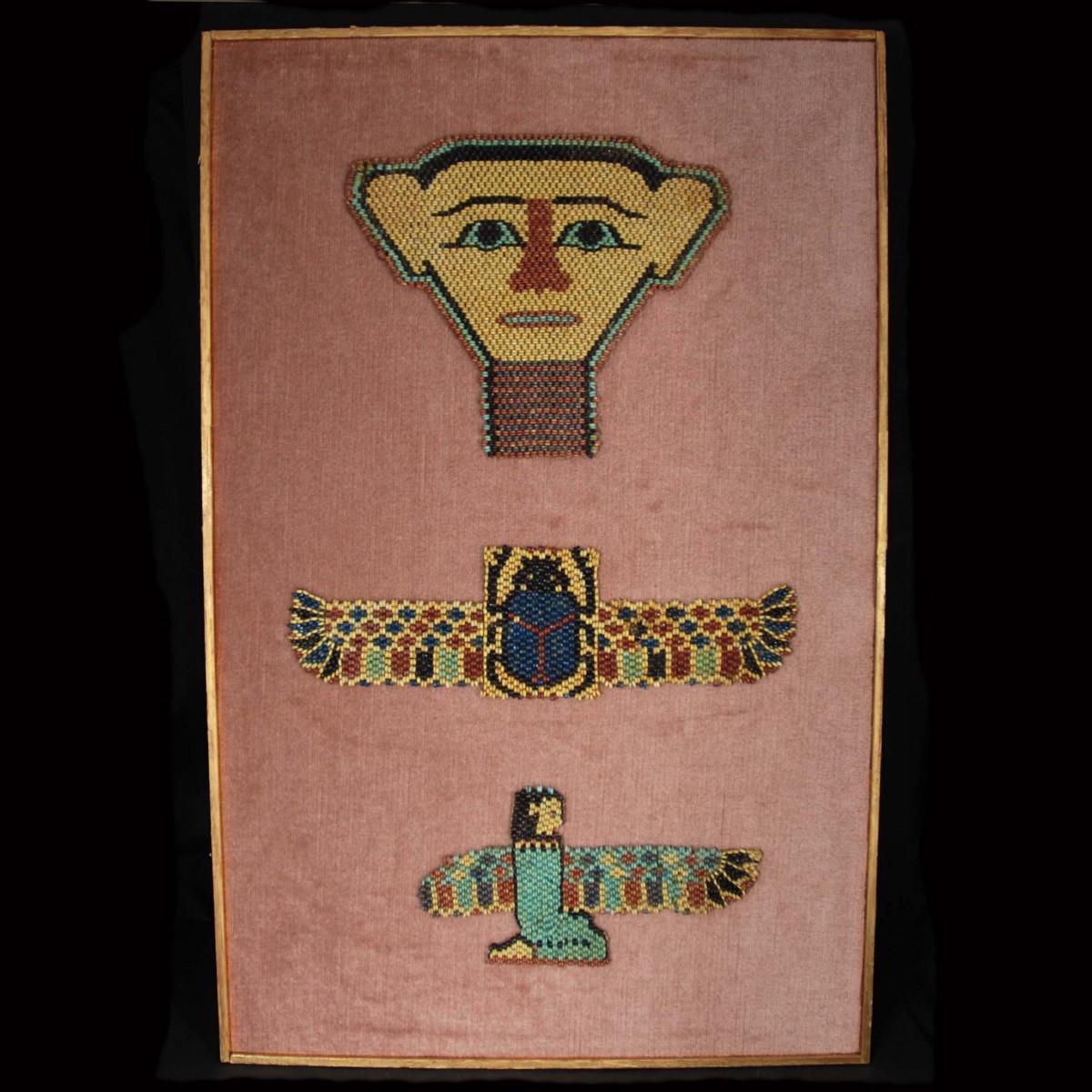
|
|
|
|
|
|
Egypt – Late period, 26th dynasty, 664-525 B.C.
|
Magnificent collection of related elements of a mummy decoration of tightly threaded, ring-shaped faience beads. The face mask, which was placed on the face of the mummy, with yellow base color, red nose, mouth framed in red and red beard as well as turquoise eyes and turquoise mouth. The pupils, brows and hair are in black. The winged scarab, the symbol of rebirth, is of exceptionally fine quality. The wings with a play of color of red, blue, green and black. The body of the scarab in blue, the limbs and the head in black, the eyes red. Very rare is the depiction of the winged Isis of faience beads. The goddess kneeling and facing to the right in a turquoise gown with black hair and also colorful play of color on the wings. The decoration still with its original linen threading is adhered on a rose-colored textile and framed by a gilded bar. At the back a fastening for mounting on the wall.
|
Provenance: Private collection D., Paris. Acquired by the parents of the last owner in the 1980s.
Dimensions: 60 cm x 38.5 cm (frame); 18.8 cm x 21.4 cm (face mask); 8.5 cm x 28.6 cm (scarab); 10.6 cm x 19.5 cm (Isis)
Price: 10 000 Euro
|
|
|
|
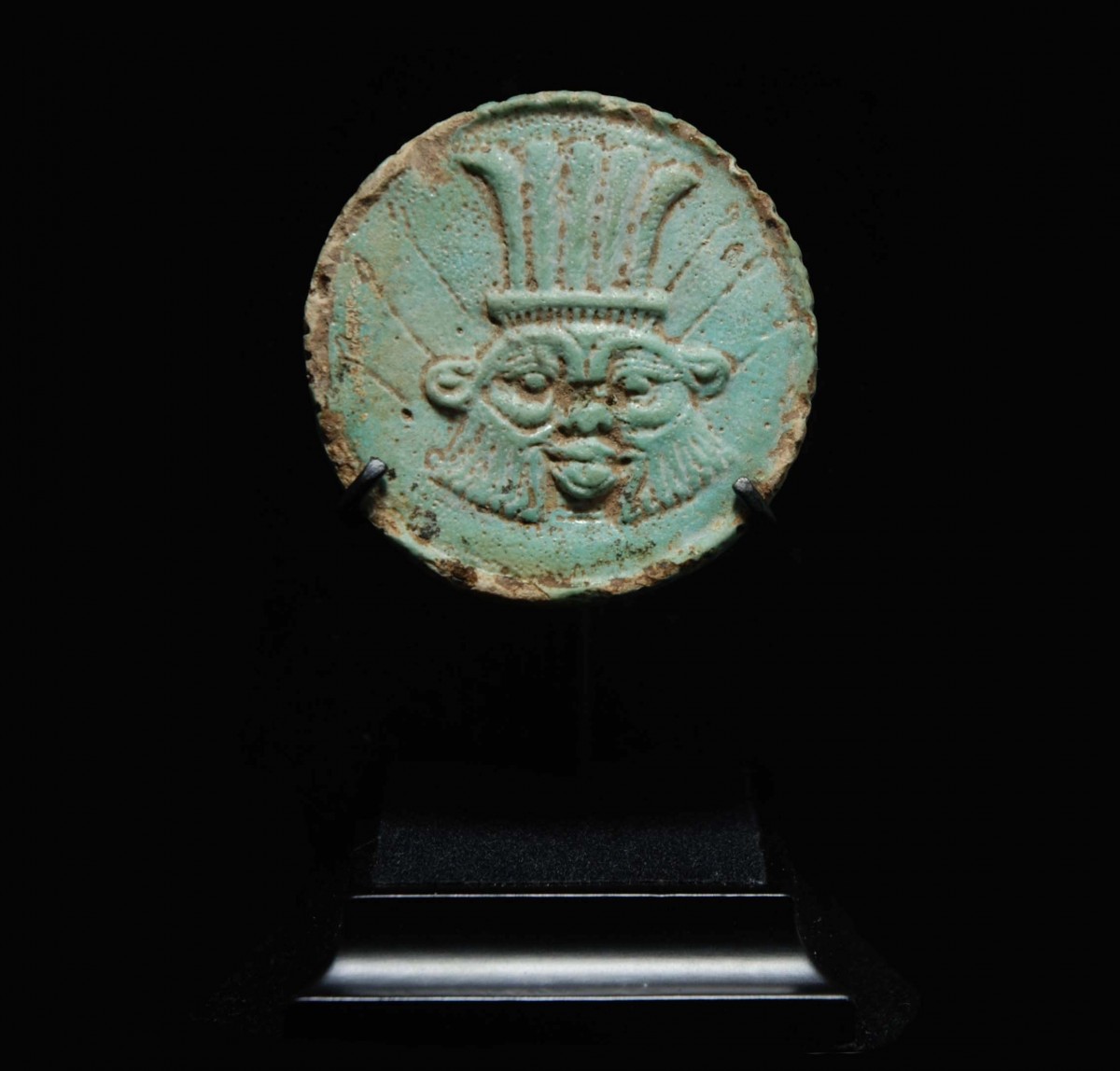
|
|
|
|
|
|
Egypt – 3rd Intermediate period, ca. 7 century B.C.
|
Large faience amulet worked out on both sides. One side depicts the head of the dwarf god Bes, the protector of pregnant women and newborn children. Bes has his typical shaggy beard, the grotesque face and protruding ears. He wears a feather crown. The other side depicts a Horus eye in relief. The Horus eye is the restored left eye (“Moon eye”) of the Light god Horus which was healed by the Egyptian god Thoth. It is also called as the udjat eye (udjat = intact, complete, healed, healthy). According to its meaning udjat amulets had an apotropaic function and should protect against illnesses. The outside of the round medallion with ribs. A perforation from one end to the other served for suspension. A modern inscription on the rim “Rop Tell Gaief” could indicate the ancient site Naucratis. Mounted.
|
Provenance: Jakob Koller, acquired in the late 19th to early 20th century in Egypt. Thence collection Richard James, New Jersey, USA, acquired in the late 1960s. Christie’s New York auction on 25 October 2007, lot 20. Last in an US private collection.
Dimensions: 5.2 cm in diameter
Price: 3 200 Euro
|
|
|
|
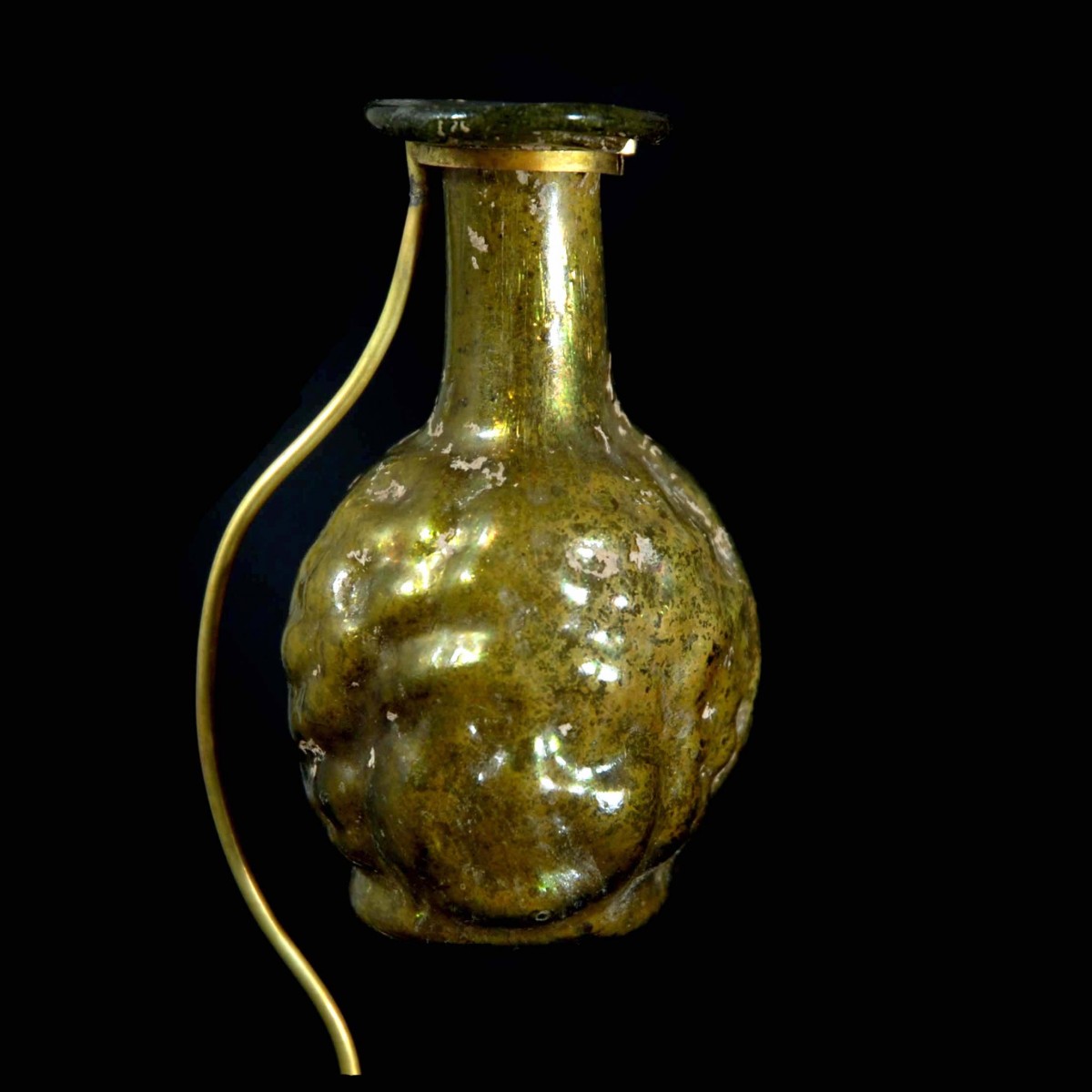
|
|
|
|
Roman Empire – 2nd-3rd century A.D.
|
Flask blown from two parts of olive green clear glass with a Janus head of a youth. The young boy with chubby cheeks, round chin and broad nose, as well as thick curls framing his face. The neck is long and cylindrical, the spout horizontally pulled outwards and thickened. The base is flat. With beautifully shimmering iridescence. Published in: K. Hamma (ed.) “The Dechter Collection of Greek Vases“, San Bernardino 1989, page 85, number 45. For the type see: Stern, E. M., Toledo Museum of Art, 1995, No. 149. Mounted.
|
Provenance: Collection Hanita and Aaron Dechter acquired prior to 1989. Exhibited in the California State University San Bernadino and California State University Northridge from 5 May to 2 June 1989 and from 26 February to 30 March 1990.
Dimensions: 8.6 cm highPrice: 1 600 Euro
Price: 1 600 Euro
|
|
|
|
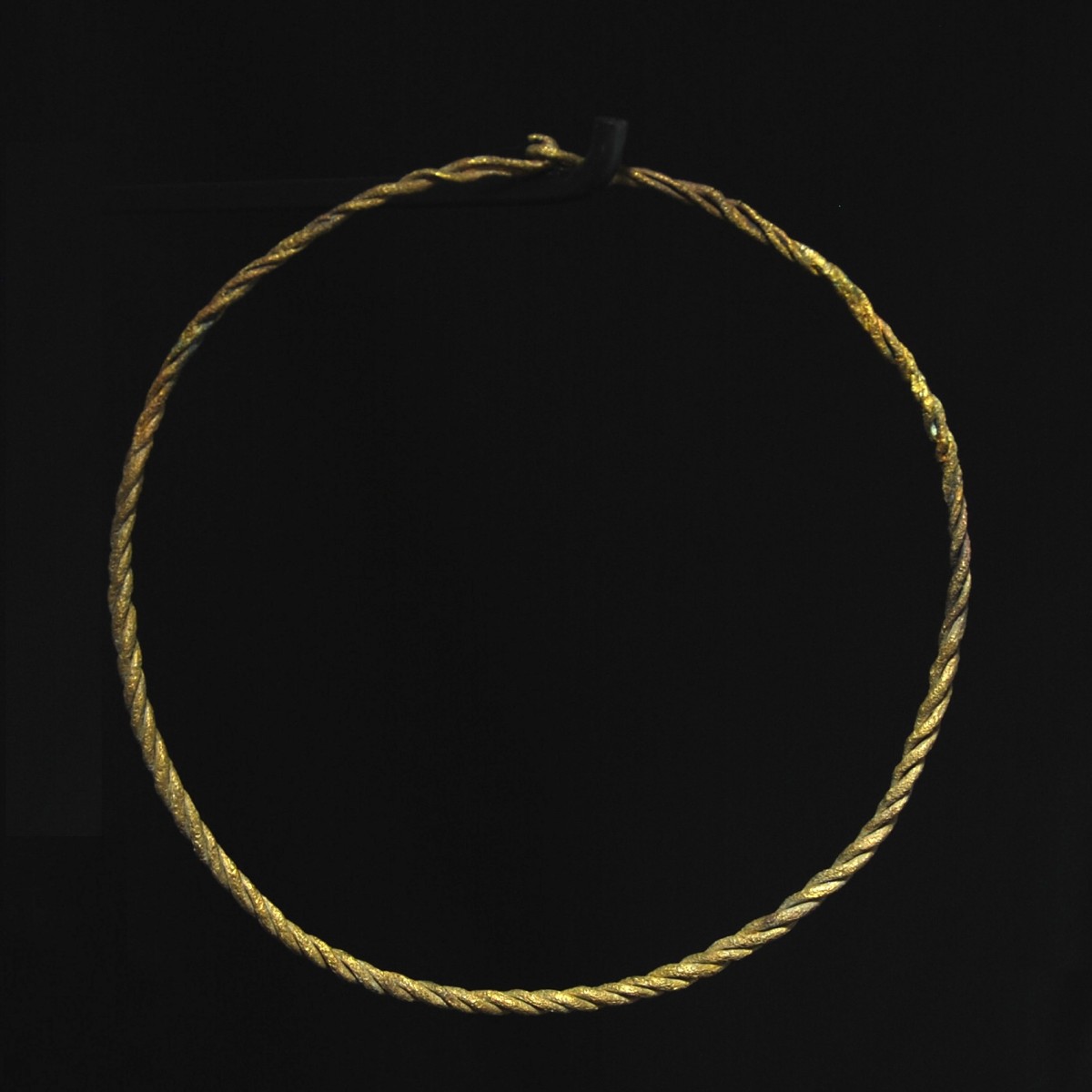
|
|
|
|
Middle Europe – 2nd-1st century B.C.
|
Torques made of two twisted bronze wires. One end is designed as a knotted eyelet, while the other one forms a hook from the two wires. With gold shimmering river patina.
|
Provenance: Galerie Antiken-Kabinett Gackstätter, inventory number 03650. With an expertise by the Antiken-Kabinett Gackstätter.
Dimensions: 13.4 cm in diameter
Price: 120 Euro
|
|
|
|
|
|
Besuchen Sie uns auf den Art Austria Higlights von 14.-17. Oktober in Wien
|
ART&ANTIQUE in der Wiener Hofburg. Weiter gehts dann bei der ART&ANTIQUE, der Traditionsmesse in der Wiener Hofburg. Sie findet von 4. bis 8. November statt. Unsere Highlights dort? Die verraten wir Ihnen in unserem nächsten Newsletter – oder Sie schauen einfach vorab bei uns im Showroom vorbei. So viel sei verraten: Diese Stücke von höchster Qualität hat bisher noch keiner gesehen.
|
|
|
|
Unser Highlight des Monats:
|
|
Römisches Reich – 1.-2. Jahrhundert n. Chr.
|
Prachtvolle und emotionale Marmorstatue eines bärtigen Silenus, der liebevoll den noch in Tücher gewickelten kleinen Bacchus im Arm hält. Die Figur des beleibten Silenus entwächst dabei aus großen Akanthusblättern. Silenus hat einen Umhang um den Wamst gewickelt, sein Haupt ist bis auf einen Haarkranz kahl, sein langer, welliger Bart reicht im fast bis zur Brust. Er hat die Arme abgewinkelt und blickt zärtlich auf den neugeborenen Bacchus. Das Kleinkind hält die rechte Hand zum Kopf und blickt lächelnd auf seinen Beschützer. Der göttliche Dionysos, bei den Römern Bacchus genannt, wurde weit vom Berg Olymp von Nymphen und Silenoi aufgezogen. Grund dafür war der Zorn der Göttin Hera, da ihr Gatte Zeus mit Dionysos‘ Mutter Semele eine Affäre hatte und das Kind zeugte. Die Darstellung des väterlichen Silenus basiert auf einer griechischen Bronze-Statue des Lysipp, die etwa 300 bis 280 vor Christus gefertigt wurde. Die bekannteste römische Darstellung aus Marmor befindet sich heute im Louvre mit der Katalognummer Ma 922. Die Darstellung mit dem massiven Blütenkelch als Fuß deutet darauf hin, dass diese Statue als Tischfuß (Trapezophoros) diente. Publiziert in: Royal-Athena Galleries „Art of the Ancient World Vol. VI”, New York 1985, Nummer 213. Gesockelt.
|
Provenienz: Galerie La Reine Margot, Paris seit den 1970er Jahren. 1984 bei Royal-Athena Galleries in New York. Dort erworben von Marilynn und James A., Chicago, im Jahr 1985. Bis zuletzt in Familienbesitz.
Höhe: 49,5 cm
Price: 60.000 Euro
|
|
|
|
Ausgewählte Kunstwerke des Monats:
|
|
Etrurien – 2. Jahrhundert v. Chr.
|
Mehrfach publizierte Ascheurne aus Alabaster mit einem Hochrelief auf einer Längsseite. Die Darstellung zeigt die Wiedererkennung des Paris als Sohn des Priamos aus dem Trojanischen Zyklus. Paris ist in der Mitte dargestellt, er stützt sein linkes Knie zum Schutz auf dem Altar des Zeus ab. In seiner rechten Hand hält er ein Schwert, in der linken die Siegespalme. Von links packt ihn sein Bruder Deiphobos an Arm und Schulter. Paris, vermeintlich ein Hirte, hatte zuvor die Opferspiele um einen Stier, der sein Lieblingstier war, gewonnen und die königliche Familie damit vor den Kopf gestoßen. Als diese ihn zur Rechenschaft ziehen will, flieht er zum Altar. Rechts steht seine Schwester Kassandra, eine Wahrsagerin, die den als Kind verlorenen Bruder, der von Hirten aufgezogen wurde, wiedererkennt. Rechts außen blickt wohl der bärtige König Priamos aufgeregt zum Geschehen und hält eine weitere bewaffnete Person zurück. Links außen ein weiterer Krieger mit Helm, Bogen und Schwert. Die Seitenwände glatt. Die Urne mit ihrer dynamischen Darstellung ist publiziert in: K. Hamma (Hg.) „The Dechter Collection of Greek Vases“, San Bernadino 1989, Seite 83, Nummer 4. Gesockelt.
|
Provenienz: Christie’s New York Auktion im Juli 1984, Los 236. Danach in der Sammlung Hanita und Aaron Dechter vor 1989. Ausgestellt in der California State University San Bernadino und California State University Northridge vom 5. Mai bis 2. Juni 1989 und vom 26. Februar bis 30. März 1990.
Dimensionen: 36 cm x 50,2 cm x 19 cm
Preis: 14.000 Euro
|
|
|
|
|
Griechenland – Anfang 5. Jahrhundet v. Chr.
|
Große und mehrfach publizierte Bronzemaske eines Silenus. Die prachtvolle Applike, die einst eine monumentale Situla schmückte, zeigt das expressive Gesicht eines bärtigen Mannes. Der Bart ist lang und rund, die Strähnen sind fein modelliert. Der lange Schnauzer hängt geschwungen vom Mund herab. Silenus hat volle Lippen mit punktförmigem Philtrum. Die Nase ist knollig, die wulstigen Brauen umrahmen oben die Augen, die mandelförmig hinter dicken Lidern hervorlugen. Die Ohren sind vor den markanten Rotellen reliefartig angedeutet. Das Haar ist strichförmig in Kaltarbeit in die Stirn geritzt. Die drei Original-Stifte, mit denen die Maske angebracht war, sind noch erhalten. Publiziert in: H. Hoffman „The Beauty of Ancient Art, the Norbert Schimmel Collection”, Mainz 1964, Nummer 16. O. Muscarella (Herausgeber) “Ancient Art, the Norbert Schimmel Collection“, Mainz 1974, Nummer 31. J. Settgast „Von Troja bis Amarna, die Sammlung Norbert Schimmel“, Mainz 1978, Nummer 35.
|
Provenienz: Privatsammlung Norbert Schimmel (1905-1990), erworben vor 1964 in New York. Danach Sotheby’s New York „Important Antiquities from the Norbert Schimmel Collection” am 16. Dezember 1992, Los 48. Dort erworben von Herbert A. Cahn, Basel. Dort erworben von der Sammlung Donald Vollen, Basel, im Jahr 1993. Bei Christie’s London am 6. Dezember 2017, Los 41. Zuletzt in einer amerikanischen Privatsammlung.
Dimensionen: 10,6 cm x 10,4 cm
Preis: 16.000 Euro
|
|
|
|
|
Thrakien – 6.-5. Jahrhundert v. Chr.
|
Ovales Silberblech mit getriebener und punzierter Darstellung einer weiblichen Gottheit, die in einem von einem galoppierenden Pegasus gezogenen, reich dekorierten Streitwagen sitzt. In ihrer rechten Hand hält sie einen Bogen, das Gesicht ist dem Betrachter zugewandt. Sie trägt ein langes Gewand, die Haare fallen ihr seitlich über die Schläfen. Über der Szene ein Sonnenrad. Außen umlaufend ein punzierter Zierrand. Unter dem geflügelten Pferd ein florales Gewächs. An vier Stellen feine Lochungen zum Aufnähen. Gesockelt.
|
Provenienz: Aus deutscher Privatsammlung, versteigert am 11. April 2008 bei Hermann Historica in München. Danach Royal Athena Gallery New York. Dort verkauft am 14. August 2008. Mit Kopie der Original-Rechnung.
Dimensionen: 9 cm x 15,2 cm
Preis: 8.000 Euro
|
|
|
|
|
Ägypten – 3. Zwischenzeit, 25. Dynastie, Herrschaft des Taharqa, 690-664 v. Chr.
|
Massiv gegossene und in Kaltarbeit verzierte Bronze-Statuette eines knienden Pharaos mit Nemes-Kopftuch und falschem Bart. Es handelt sich wohl um Taharqa (690-664 v. Chr.), den wichtigsten Herrscher der kuschitischen 25. Dynastie in Ägypten. Er hat seine rechte Hand zum Gebetsgestus angehoben und hält in seiner nachvorne gestreckten linken Hand eine hockende Maat-Figur als Opfergabe. Taharqa trägt einen langen Kilt, der am Schoß verziert ist. An der Stirn ein Uräus. Die Augen mit Goldüberzug. Mit dem Originalzapfen auf einem alten Holzsockel montiert.
|
Provenienz: Dem Vernehmen nach aus der Sammlung Hilton-Price, Ende des 19. Jahrhunderts. Danach Privatsammlung Charles Bouché, erworben in den 1960er bis 1970er Jahren. Versteigert bei Drouot am 15. November 2013, Los 176.
Höhe: 6,5 cm
Preis: 4.800 Euro
|
|
|
|
|
Etrurien – 8. Jahrhundert v. Chr.
|
Frühetruskische oder Villanova Bügelhenkelkanne der Impasto-Ware in einer seltenen Form. Die Kanne mit ausladendem, rundem Korpus steht auf einem hohen Ringfuß. Der Hals verjüngt sich nach oben, der Rand ist weit auskragend. Hinter dem Ausguss setzt der Bügelhenkel an, der hinten am Rand aufsitzt und in erweiterter Form bis zum Hals reicht. Auf der Rückseite ein breiter Ringhenkel. Der Körper ist mit sehr sorgfältig eingedrücktem Dekor verziert. Das obere Band besteht aus Dreiecken, die unten mit einem punzierten Kreis abschließen. In den Dreiecken feines Schnurdekor. Darunter ein breites Mäanderband.
|
Provenienz: Deutsche Privatsammlung W. F., München, erworben in den 1990er Jahren.
Höhe: 22 cm
Preis: 4.800 Euro
|
|
|
|
|
Ägypten – Spätzeit, 26. Dynastie, 664-525 v. Chr.
|
Prachtvolle Kollektion aus zusammengehörigen Elementen einer Mumiendekoration aus dicht gefädelten, ringförmigen Fayenceperlen. Die Gesichtsmaske, die auf das Gesicht der Mumie gelegt wurde, mit gelber Grundfarbe, roter Nase, rot umrahmtem Mund und rotem Bart sowie türkisen Augen und türkisem Mund. Die Pupillen, Brauen und Haare in Schwarz. Der geflügelte Skarabäus, der das Symbol für die Wiedergeburt war, von besonders feiner Qualität. Die Flügel mit einem Farbenspiel aus rot, blau, grün und schwarz. Der Körper des Skarabäus blau, die Gliedmaßen und der Kopf schwarz, die Augen rot. Besonders selten ist die Darstellung der geflügelten Isis aus Fayenceperlen. Die nach rechts gewandte, kniende Göttin im türkisen Gewand mit schwarzem Haar und einem ebenfalls buntem Farbenspiel an den Flügeln. Die Dekoration noch mit ihrer Original-Leinenfädelung ist auf ein rosafarbenes Textil geklebt und mit einer vergoldeten Leiste gerahmt. Hinten eine Befestigung zur Wandhängung.
|
Provenienz: Privatsammlung D, Paris. Erworben von den Eltern des heutigen Besitzers in den 1980er Jahren.
Dimensionen: Dimensionen Rahmen: 60 cm x 38,5 cm; Gesichtsmaske: 18,8 cm x 21,4 cm; Skarabäus: 8,5 cm x 28,6 cm; Isis: 10,6 cm x 19,5 cm.
Preis: 10.000 Euro
|
|
|
|
|
Ägypten – 3. Zwischenzeit, ca. 7. Jahrhundert v. Chr.
|
Großes, beidseitig bearbeitetes Fayence-Amulett. Die eine Seite zeigt den Kopf des Zwergengottes Bes, dem Beschützer von Schwangeren und Neugeborenen. Bes hat seinen typischen Zottelbart, das fratzenartige Gesicht und abstehende Ohren. Er trägt eine Federkrone. Auf der anderen Seite ist ein Horusauge im Relief dargestellt. Das Horusauge ist das vom ägyptischen Gott Thot geheilte, wiederhergestellte linke Auge („Mondauge“) des Lichtgottes Horus. Es wird auch als Udjat-Auge bezeichnet (udjat = intakt, vollständig, heil, gesund). Entsprechend seiner Bedeutung hatten Udjat-Amulette apotropäische Funktion und sollten vor Krankheiten schützen. Die Außenseite des runden Medaillons mit Rippen. Eine Bohrung von Rand zu Rand diente zur Aufhängung. Eine moderne Inschrift am Rand „Rop Tell Gaief“ dürfte auf den Fundort, das antike Naukratis hinweisen. Gesockelt.
|
Provenienz: Jakob Koller, erworben Ende des 19. bis Anfang des 20. Jahrhunderts in Ägypten. Danach Sammlung Richard James, New Jersey, USA, erworben in den späten 1960er Jahren. Christie’s New York Auktion vom 25. Oktober 2007, Los 20. Zuletzt in amerikanischem Privatbesitz.
Durchmesser: 5,2 cm
Preis: 3.200 Euro
|
|
|
|
|
Römisches Reich – 2.-3. Jahrhundert n. Chr.
|
In eine zweiteilige Form geblasene Flasche aus olivgrünem Klarglas mit dem janusförmigen Gesicht eines Jünglings. Der Knabe mit Pausbacken, rundem Kinn und breiter Nase sowie dicken, das Gesicht einrahmenden Locken. Der Hals ist lang und zylinderförmig, die Öffnung horizontal nach außen gezogen und heiß verdickt. Die Basis ist flach. Mit wunderbar schimmernder Irisierung. Publiziert in: K. Hamma (Hg.) „The Dechter Collection of Greek Vases“, San Bernadino 1989, Seite 85, Nummer 45. Vergleiche zum Typus: Stern, E. M., Toledo Museum of Art, 1995, No. 149. Gesockelt.
|
Provenienz: Sammlung Hanita und Aaron Dechter erworben vor 1989. Ausgestellt in der California State University San Bernardino und California State University Northridge vom 5. Mai bis 2. Juni 1989 und vom 26. Februar bis 30. März 1990.
Höhe: 8,6 cm
Price: 1.600 Euro
|
|
|
|
|
Mitteleuropa– 2.-1. Jahrhundert v. Chr.
|
Torques aus zwei miteinander verschlungenen Bronzedrähten. Ein Ende ist als verknotete Öse ausgebildet, während das andere aus den beiden Drähten einen Haken formt. Mit Gold schimmernder Flußpatina.
|
Provenienz: Galerie Antiken-Kabinett Gackstätter, Inventarnummer 03650. Mit Expertise des Antiken-Kabinett Gackstätter.
Durchmesser: 13,4 cm
Preis: 120 Euro
|
|
|
|
|
|
|
CHRISTOPH BACHER ARCHÄOLOGIE ANCIENT ART GmbH
|
Galerie: Stubenring 20, A-1010 Wien
Showroom: Untere Viaduktgasse 55, A-1030 Wien
|
|
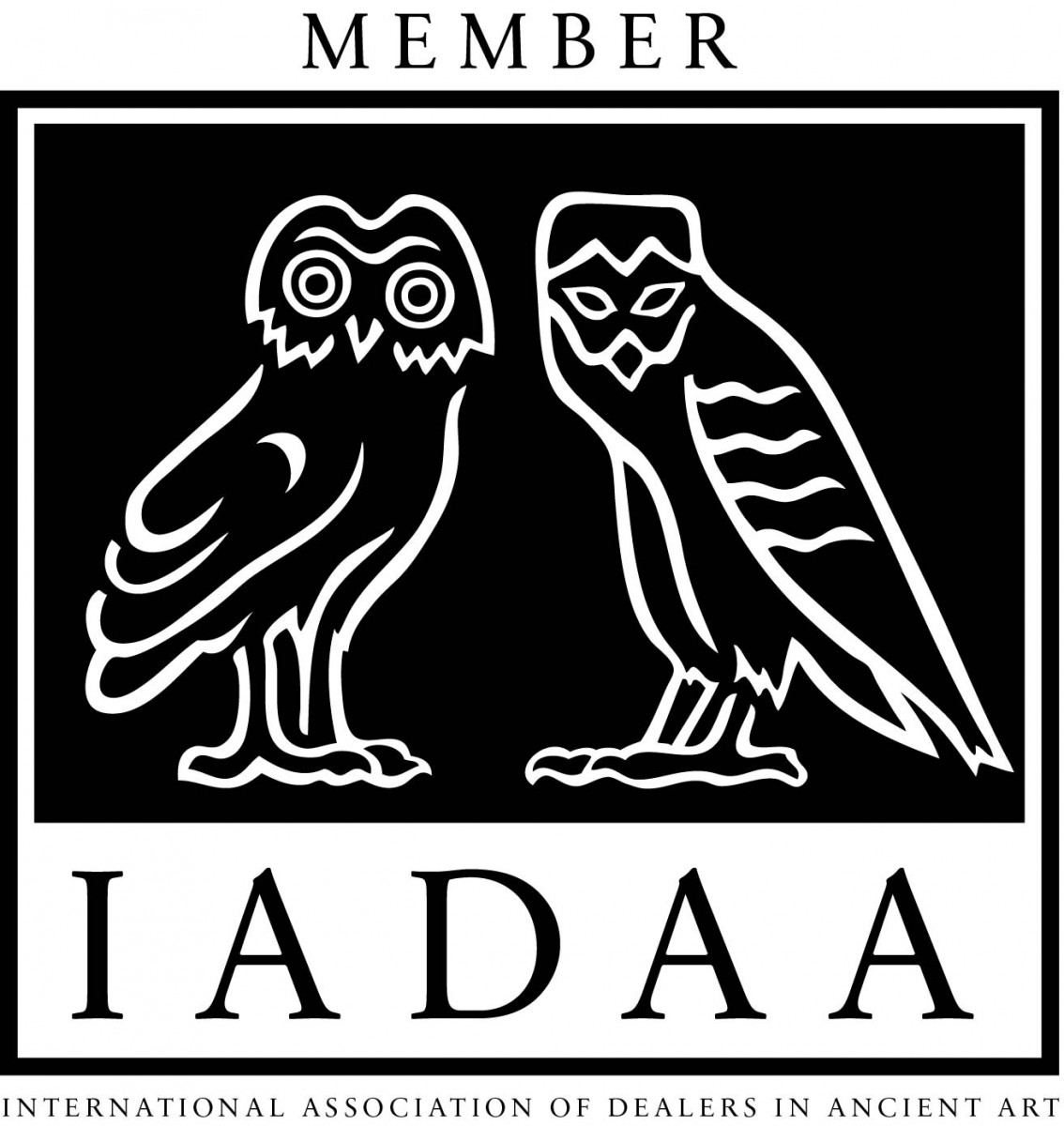
|
|
|
|